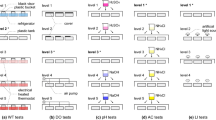Abstract
The golden mussel, Limnoperna fortunei, is native to South China but has spread to Japanese freshwater environments as a nuisance invasive species. The golden mussel colonizes hard manmade substrates and its attachment can cause economic losses at water intake facilities. To evaluate the repellent effects of the high alkalinity (pH 12–13) of freshly prepared cement mortar on golden mussels, test pieces made of cement were immersed in a Japanese urban tidal river. Compared with coated mortar, and wood and limestone test pieces, the cement mortar did not show significant repellent effects on golden mussel attachment. Therefore, concrete constructions on riverbanks may be a preferred substrate for golden mussel colonization. A 4-year immersion experiment showed that copper substrate had a strong repellent effect on biofouling, while cement mortar, aluminum, and stainless steel did not have any adverse effects on golden mussel attachment. This experiment also revealed the settlement of invasive golden mussel in an urban tidal area where the salinity fluctuated up to 20.0‰.

The aerial photo was taken by the Geospatial Information Authority of Japan (GSI) in 2006




Similar content being viewed by others
References
Boltovskoy D, Correa N (2015) Ecosystem impacts of the invasive bivalve Limnoperna fortunei (golden mussel) in South America. Hydrobiologia 746:81–95
Chen D, Gerstenberger SL, Mueting SA, Wong WH (2011) Environmental factors affecting settlement of quagga mussel (Dreissena rostriformis bugensis) veligers in Lake Mead, Nevada–Arizona, USA. Aquat Invasions 6:149–156
Darrigran G, Damborenea C, Drago EC, Ezcurra de Drago I, Paira A (2011) Environmental factors restrict the invasion process of Limnoperna fortunei (Mytilidae) in the Neotropical region: a case study from the Andean tributaries. Ann Limnol Int J Limnol 47:221–229
Environmental Risk Research Center (2017) Limnoperna fortunei. In: Invasive species of Japan. National Institute for Environmental Studies. https://www.nies.go.jp/biodiversity/invasive/DB/detail/70200e.html. Accessed 19 August 2018
Gopalakrishnan S, Thilagam H, Raja PV (2007) Toxicity of heavy metals on embryogenesis and larvae of the marine sedentary polychaete Hydroides elegans. Arch Environ Contam Toxicol 52:171–178
Irie M, Nishida S, Shoji Y (2008) Temporal and spatial characteristics of water quality and its responses to tide in urban tidal river network (in Japanese). Ann J Hydraul Eng JSCE 52:1099–1104
Iwasaki K, Yamamoto H (2014) Recruitment and population structure of the non-indigenous brackish-water mytilid Xenostrobus securis (Lamark 1819) in the Kino River, Japan. Aquat Invasions 9:479–487
Kadar E, Salanki J, Jugdaohsingh R, Powell JJ, McCrohan CR, White KN (2001) Avoidance responses to aluminium in the freshwater bivalve Anodonta cygnea. Aquat Toxicol 55:137–148
Kawakami H, Yoshida K, Nishida Y, Kikuchi Y, Sato Y (2008) Antibacterial properties of metallic elements for alloying evaluated with application of JIS Z 2801:2000. ISIJ Int 48:1299–1304
Kimura T (1994) The earliest record of Limnoperna fortunei (Dunker) from Japan (in Japanese). Chiribotan 25:34–35
Kimura T, Inoue A, Kimura S, Sato T (2011) Spatial distribution of an exotic mussel, Limnoperna fortunei, in Lake Biwa and connected waters in western Japan (in Japanese). Sessile Org 28:9–18
Magara Y, Matsui Y, Goto Y, Yuasa A (2001) Invasion of the non-indigenous nuisance mussel, Limnoperna fortunei, into water supply facilities in Japan. J Water Supply Res Technol 50:113–124
Maresca JA, Moser P, Schumacher T (2017) Analysis of bacterial communities in and on concrete. Mater Struct 50:25
Morton B, Dinesen GE (2010) Colonization of Asian freshwaters by the Mytilidae (Bivalvia): a comparison of Sinomytilus harmandi from the Tonle-Sap River, Phnom Penh, Cambodia, with Limnoperna fortunei. Molluscan Res 30:57–72
Nakano D, Strayer DL (2014) Biofouling animals in fresh water: biology, impacts, and ecosystem engineering. Front Ecol Environ 12:167–175
Nakano D, Baba T, Endo N, Nagayama S, Fujinaga A, Uchida A, Shiragane A, Urabe M, Kobayashi T (2014) Invasion, dispersion, population persistence and ecological impacts of a freshwater mussel (Limnoperna fortunei) in the Honshu Island of Japan. Biol Invasions 17:743–759
Nandakumar K, Matsunaga H, Takagi M (2003) Microfouling studies on experimental test blocks of steel-making slag and concrete exposed to seawater off Chiba, Japan. Biofouling 19:257–267
O’Connor NJ, Richardson DL (1998) Attachment of barnacle (Balanus amphitrite Darwin) larvae: responses to bacterial films and extracellular materials. J Exp Mar Biol Ecol 226:115–129
Omae I (2003) General aspects of tin-free antifouling paints. Chem Rev 103:3431–3448
Pejchar L, Mooney HA (2009) Invasive species, ecosystem services and human well-being. Trends Ecol Evol 24:497–504
Pérez MC, García M, Traversa L, Stupak M (2003) Concrete deterioration by golden mussels. Conference on microbial impact on building materials. RILEM Publications, Lisbon, pp 39–47
Ricciardi A (1998) Global range expansion of the Asian mussel Limnoperna fortunei (Mytilidae): another fouling threat to freshwater systems. Biofouling 13:97–106
R Development Core Team (2018) R: a language and environment for statistical computing. Vienna: R Foundation for Statistical Computing. (http://www.R-project.org). Accessed 14 Apr 2018
Sylvester F, Cataldo DH, Notaro C, Boltovskoy D (2013) Fluctuating salinity improves survival of the invasive freshwater golden mussel at high salinity: implications for the introduction of aquatic species through estuarine ports. Biol Invasions 15:1355–1366
Wahl M (1989) Marine epibiosis. I. Fouling and antifouling: some basic aspects. Mar Ecol Prog Ser 58:175–189
Xu M, Darrigran G, Wang Z, Zhao N, Lin CC, Pan B (2015) Experimental study on control of Limnoperna fortunei biofouling in water transfer tunnels. J Hydro Environ Res 9:248–258
Yao GY, Xu MZ, An XH (2017) Concrete deterioration caused by freshwater mussel Limnoperna fortunei fouling. Int Biodeter Biodegr 121:55–65
Acknowledgements
This study was mainly supported by the Nippon Life Insurance Foundation. KM was also supported by Kindai University RK22-KM (2010) and RK-066 (2014). We thank the members of our laboratories for help with the field experiments and the Osaka Public Works Bureau for providing the space for the field experiments. We also acknowledge valuable comments by anonymous reviewers and the associate editor.
Author information
Authors and Affiliations
Corresponding author
Additional information
Handling Editor: Yuichi Iwasaki.
Rights and permissions
About this article
Cite this article
Matsui, K., Fumoto, T. & Kawakami, H. Testing the repellent effects of construction materials on the attachment of the invasive golden mussel, Limnoperna fortunei, in a Japanese urban tidal river. Limnology 20, 131–136 (2019). https://doi.org/10.1007/s10201-018-0559-x
Received:
Accepted:
Published:
Issue Date:
DOI: https://doi.org/10.1007/s10201-018-0559-x




